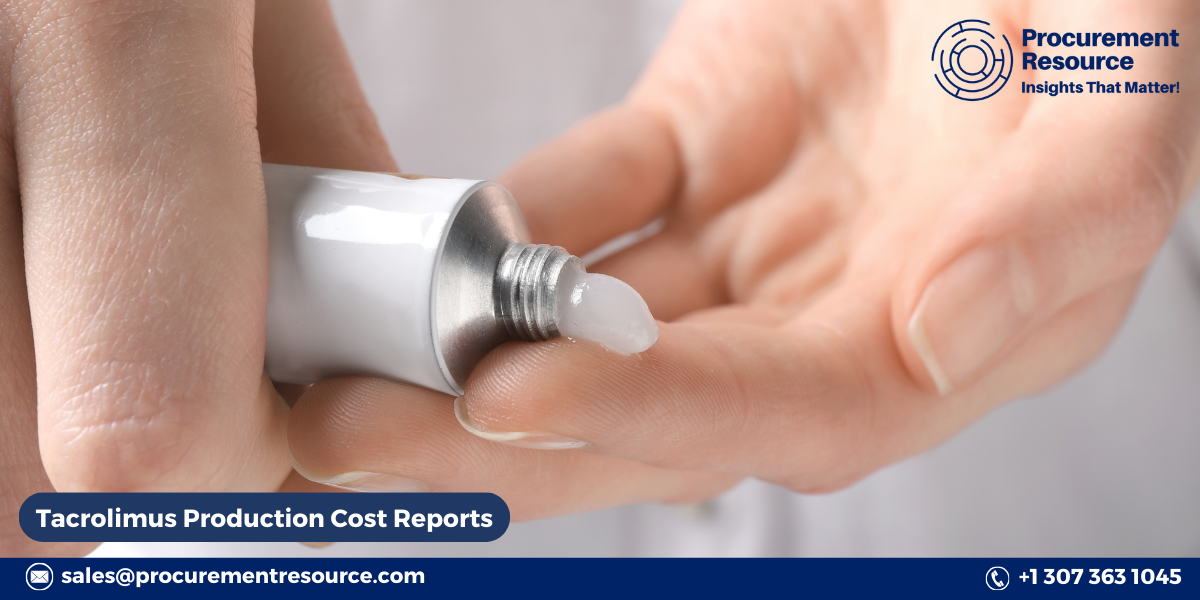
Tacrolimus is an immunosuppressive drug widely used in organ transplantation to prevent the rejection of organs such as kidneys, liver, and heart. Its production process involves a series of intricate steps, each requiring precision to maintain the quality and efficacy of the drug. In this blog, we will explore the detailed production process of Tacrolimus, key factors influencing the production, and a look into the cost drivers and challenges associated with its manufacturing.
1. Overview of Tacrolimus
Tacrolimus (C₄₄H₆₉NO₁₂) is a macrolide compound derived from Streptomyces tsukubaensis. It works by inhibiting T-cell activation, which is critical in immune responses, thus helping in the prevention of organ rejection. Tacrolimus is considered more potent than another common immunosuppressant, cyclosporine, and has a narrower therapeutic window, meaning its dosage must be carefully monitored.
2. Tacrolimus Production Process
a) Fermentation Process
The first step in the production of Tacrolimus involves fermentation. Streptomyces tsukubaensis, the microorganism responsible for the production, is grown in a nutrient-rich environment.
Request For Sample: https://www.procurementresource.com/production-cost-report-store/tacrolimus/request-sample
- Media Preparation: The fermentation medium consists of sources of carbon (like glucose or sucrose), nitrogen (ammonium sulfate), and various micronutrients essential for microbial growth.
- Fermentation Conditions: The microorganism is cultivated under carefully controlled conditions, with parameters such as temperature, pH, and aeration being optimized to maximize the production of Tacrolimus. This step typically lasts several days.
- Harvesting: After the fermentation process is complete, the broth containing Tacrolimus is harvested. The fermentation broth contains both the drug and various impurities, making the next steps crucial for drug purity.
b) Extraction and Isolation
Once fermentation is completed, Tacrolimus is extracted from the fermentation broth. This process involves several stages of solvent extraction to isolate the drug.
- Solvent Extraction: Organic solvents such as ethyl acetate or butanol are used to extract Tacrolimus from the aqueous fermentation broth. Multiple extractions are often required to ensure high recovery rates of the drug.
- Crystallization: After extraction, crystallization is employed to purify the Tacrolimus. The drug is dissolved in an appropriate solvent and allowed to crystallize under controlled conditions to ensure maximum purity. This step may be repeated several times to meet pharmaceutical-grade standards.
c) Purification
Further purification steps are employed to remove any residual impurities. High-performance liquid chromatography (HPLC) is often used as a final purification step. This ensures that the final product meets the strict quality guidelines for pharmaceutical use.
- Column Chromatography: This method is used to purify Tacrolimus by passing it through a stationary phase that separates impurities based on size and chemical properties.
d) Drying and Milling
After purification, the final product is dried to remove any residual solvents or moisture. The dried product is then milled to achieve the desired particle size for formulation purposes.
- Lyophilization: This is the preferred method of drying Tacrolimus, as it preserves the drug’s stability and potency by removing water under low temperature and pressure.
3. Key Production Factors
a) Fermentation Optimization
The yield of Tacrolimus is heavily dependent on the efficiency of the fermentation process. Factors such as the strain of Streptomyces tsukubaensis, the fermentation medium, and the environmental conditions play a critical role in maximizing production yields.
b) Purity Requirements
As an immunosuppressive drug, Tacrolimus requires exceptionally high purity. Therefore, multiple steps of extraction, crystallization, and chromatography are employed to ensure that the final product meets pharmaceutical standards.
c) Process Efficiency
The extraction and purification processes are vital in determining the overall efficiency of Tacrolimus production. Solvent consumption, extraction time, and crystallization yield directly influence the cost and scalability of production.
4. Cost Drivers in Tacrolimus Production
a) Raw Materials
The quality and cost of raw materials, especially carbon and nitrogen sources for fermentation, significantly affect production costs. The choice of solvents for extraction and purification also plays a major role in driving costs.
b) Fermentation Time
The length of the fermentation process, typically spanning several days, adds to production costs. Faster, optimized fermentation can reduce operational expenses.
c) Equipment and Facility Costs
The high-tech equipment required for fermentation, extraction, crystallization, and purification is a significant capital expenditure. Additionally, maintaining a controlled environment for microbial growth and drug extraction further adds to costs.
d) Regulatory Compliance
Since Tacrolimus is a critical pharmaceutical product, manufacturers must adhere to stringent regulations concerning drug quality, safety, and purity. Compliance with Good Manufacturing Practices (GMP) and various regulatory guidelines adds to both operational complexity and cost.
5. Challenges in Tacrolimus Manufacturing
a) Yield Optimization
Achieving high yields of Tacrolimus during fermentation can be challenging. Manufacturers continuously research strain improvements and process optimizations to enhance microbial productivity and maximize yield.
b) Purity Maintenance
Given the narrow therapeutic window of Tacrolimus, maintaining consistent purity levels across batches is essential. Even minor impurities can significantly impact the drug’s efficacy and safety.
c) Environmental and Waste Management
The solvents used in Tacrolimus extraction and purification pose environmental challenges. Proper disposal or recycling of solvents is critical to ensure compliance with environmental regulations.
Tacrolimus production is a complex and highly specialized process that involves multiple stages, from microbial fermentation to purification and final formulation. The success of the production process relies on optimizing fermentation conditions, efficient solvent extraction, and rigorous purification techniques. However, the process comes with challenges such as yield optimization, purity control, and high production costs due to the stringent regulatory and operational requirements.
Tacrolimus remains an indispensable drug in modern medicine, especially in transplant surgery, and ongoing advancements in biotechnology are expected to further enhance its production efficiency, making it more accessible to patients worldwide.
Contact Us:
Company Name: Procurement Resource
Contact Person: Endru Smith
Email: sales@procurementresource.com
Toll-Free Number: USA & Canada - Phone no: +1 307 363 1045 | UK - Phone no: +44 7537 132103 | Asia-Pacific (APAC) - Phone no: +91 1203185500
Address: 30 North Gould Street, Sheridan, WY 82801, USA




